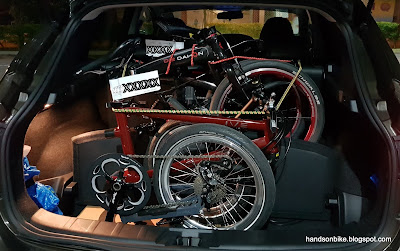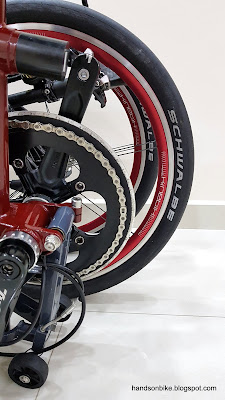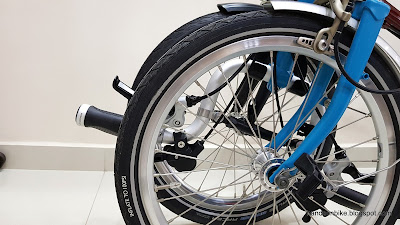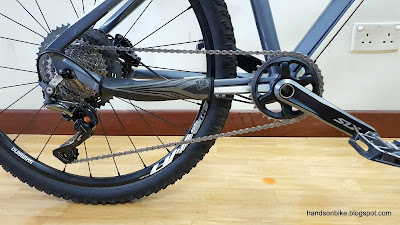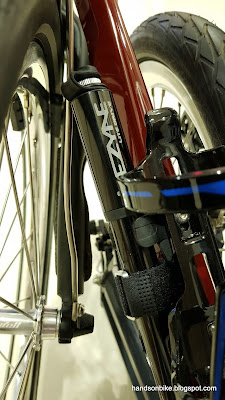Previously we looked at the various components of the Tyrell IVE, the folding mechanism, and then the folded size comparison with the Dahon and Brompton. Now, after testing it for a longer distance, I can give a more balanced and comprehensive review.
For this comparison, it will mainly be done against the Dahon and Brompton, which are the typical 20 inch folding bike and the 16 inch folding bike. For some of the attributes that I chose to highlight, it will be compared against each of these bikes to see where it stands.
Do take note that there are many attributes that will collectively define a bicycle as good or not, so we cannot just judge it based on one or two items. Of course, if those attributes are very critical to you (such as folded size or price), they will naturally carry more weight when you are selecting the ideal bike for your needs.
The final test ride was done during the OCBC Cycle 2018, which is a good chance to fully evaluate the Tyrell IVE. It consists of fast rolling flats, some longer upslopes (Sheares Avenue), and also fast downhills. Most importantly, I have done a similar route on the Dahon MuEX and the Brompton M6R on previous years as well, so it is a relatively fair comparison.
Starting off with the transportation of the bikes to the OCBC Cycle start point, let's compare the Tyrell IVE with the other bikes and finally the overall ride quality.
Transporting two folding bikes is easy. Just put both of them in the car boot and you are good to go! No need to fold down the car seats or remove the bicycle wheels.
Practically, in terms of transportation size when putting the folded bike into the car, the Tyrell IVE fits in a similar space as the Brompton, even though it is larger in terms of folded size. Unless your Brompton already fits tightly without any extra space around it, the Tyrell IVE should also fit quite easily in the same space.
Saddle
Even though I was wearing padded cycling shorts, the stock saddle started to feel uncomfortable for me after just 10km. I have used saddles with even less padding (such as the Selle Italia SLR Kit Carbonio Flow), without much discomfort, even after longer distances, so I can say that my butt is rather seasoned in terms of bike riding.
Although the stock saddle seems wide and cushy, it does not seem to have enough support in the correct areas. It might fit well for some people, but not for me. That made the ride a little tougher that what I expected, due to the unexpected saddle discomfort.
Stock saddle is not so nice for me, although it might work well for others.
If I owned the bike, I would have changed out the saddle to my preferred brand or shape. Another reason that contributed to the butt discomfort was the more upright riding position.
Riding Posture
Being a flat handlebar bike, the riding posture is naturally more upright compared to a drop bar bike, which I am so used to. My two main bikes, the Canyon Endurace and the Avanti Inc 3 (three bikes if you count the recently-disassembled Java Freccia mini velo) all use drop bars, which I prefer due to the better ergonomics and also faster ride.
Having a more upright riding posture means that more weight is on the butt, compared to a drop bar bike where more weight is on the hands. Therefore, riding in an upright posture will make it more likely to cause butt discomfort.
This brings me to the next point, which is that the distance between the saddle and the handlebar is rather short. Once again, for people of average height or more, the posture might be too upright. This would be ideal for shorter riders, but taller riders might want to extend the reach for a more sporty riding posture.
The upright posture is similar to that on the Dahon and Brompton, so I cannot fault the Tyrell IVE on this. It is a result of using flat handlebars, which is usually used for folding bikes for a more compact fold and more casual riding.
Tyrell IVE and Dahon MuEX on top of the bridge along Sheares Avenue!
If you want to know the benefits of using a drop bar or bullhorn bar, check out this old post here!
Handlepost Stiffness
What I really liked about the handlepost is that it feels super stiff! It feels just as stiff and unyielding as the first time I tried the Tern Verge P18 a few years ago. With a stiff handlepost, you can pull on the handlebar confidently to put down the power, or pedal while standing up. This is something that the Dahon or Brompton cannot match, as their handleposts will still have some flex.
Massive handlepost design of the Tern Verge series, I was so impressed by the stiffness when I first tried the bikes.
Riding Speed and Stability
The most important attribute of a bike, in my opinion, is how well it rides. "Well" doesn't necessarily mean fast, although it is always nice to go fast with less effort. In my definition, a bike that rides well is a bike that you will want to ride again, simple as that. Be in fun, or fast, or comfortable, a bike that you like to ride is a bike that you will ride often. I have come across bikes that are not nice to ride, such as a cruiser that I tried in Long Beach, or most of the shared bikes around. OK for short distances only (less than 3km), where the alternative is a long walk.
One thing I liked is that the Tyrell IVE rides faster than the Brompton. Even though the wheelsize is similar, the Tyrell IVE just feels more stiff and lively than the Brompton. On the Brompton, even with the stiff suspension, you can still feel the bike bobbing up and down slightly when pedaling hard. There is no such phenomenon on the Tyrell IVE which feels more efficient.
Of course, the 20 inch Dahon still goes faster, as it has larger wheels, smoother tires, and is also more lightweight by almost 3 kg!
The Tyrell IVE is also very stable when rolling down the slope at 50km/h, partly due to its long wheelbase and also stable geometry. It feels even more stable than the Brompton or Dahon, which is also helped by the stiff handlepost. With a properly spaced cockpit, it will be even better.
The Tyrell IVE has a really long wheelbase!
Shifting and Braking
The stock shifters, rear derailleur and cassette that comes on the Tyrell IVE is Shimano Sora 9 speed, which is a road groupset. With proper shifters that have easy-to-operate levers, shifting operation is much easier and more intuitive compared to the Brompton 6 speed.
On the Brompton, I had to create my own DIY gear indicator, so that I know how to shift up the gears. On the Tyrell IVE, shifting is easy with no fuss.
Other than gear shifting, the brake lever position on the Tyrell is more ergonomic, as it points downwards at about 60 degrees, instead of being almost straight down as on the Brompton. With a better lever shape and better ergonomics, it is easier and more comfortable to use the brakes.
Brake lever on the Tyrell IVE has a nice lever shape and is angled downwards at a comfortable angle.
That said, most bikes have the brake levers angled correctly, it is just the Brompton that needs the straight-down angle for compact folding.
Actual shifting performance on the Tyrell IVE is also better, as it uses a normal chain and cassette, so I can shift under load even while pedaling, or even make multiple gear changes at a time. That is not possible on the Brompton, due to the nature of the Sturmey-Archer 3 speed hub that does not allow gear changing while under load. This is a big difference as I do not need to think about pedaling lightly while changing gears on the Tyrell IVE.
Using chain and cassette allows quick gear changing that is possible even while under load.
Another benefit of having 9 speeds is much better cadence control, as the steps between the gears are smaller. With that, it is easier to find a suitable gear for pedaling efficiently, which is another factor that contributes to the Tyrell IVE having a faster ride than the Brompton.
Others
The stock Tyrell IVE comes with a 53T chainring, which is too low for a regular cyclist. With a 53T/11T combination, and 16 inch wheels (although it says 18 inch, the actual size is almost same as 16 inch), the top gear is only about 80 gear inches. This means that I ran out of gears far too easily, even when cruising along on the flat. When going downhill, pedaling does not have much effect as the bike is already rolling so fast.
On the other end of the gear range, the low gear is too low, as I didn't need the lowest 2 gears even when going up Sheares avenue. It is easy to upgrade the stock chainring to 56t or even 58T, to get a gear range that is more suitable.
Stock chainguard is already 58T compatible, so you can use a larger chainring without needing to change the chainguard.
Finally, the Tyrell IVE uses mainly standard drivetrain and brake components, so it is easy to upgrade or replace components, unlike the Brompton which uses many special parts. If you want to go 10 speed, easy, just upgrade the drivetrain. Want better brake levers or calipers? Just upgrade it with standard components. The crankset can also be upgraded easily if you feel a need to do so. If you want to reduce the bike's weight, you can do all those above, plus change to a lighter wheelset.
Servicing the bike or changing the inner tube is also easy, as the Tyrell IVE uses normal wheels with quick release axles, no need to bring out a wrench to loosen the axle nuts.
Conclusion
The Tyrell IVE is a folding bike that rides surprisingly well, given its small wheel size. With a stiff frame and handlepost, putting down power is efficient and it translates into a fast ride. The stock 9 speed components are decent enough that there is no need to upgrade it, although you can do so easily if you want to.
With a stock weight of 11.5 kg (without pedals), I think it is quite feasible to reduce the weight to 10kg if you want. Just changing to a lighter wheelset and tires will yield a significant amount of weight savings. Using lighter drivetrain components will save even more weight. That is not even counting the easy ones, which is a more lightweight seatpost and saddle.
Although the folded size is not as compact as the Brompton, the ride is good, while it offers excellent flexibility and potential in terms of component upgrades and weight loss.
If you ask me to choose between the Tyrell IVE and the Brompton, it will be a difficult choice. If I absolutely need a compact folded size and don't plan to upgrade the components, the Brompton will be ideal. However, if I want to upgrade the components easily, and want better shifting performance, while only needing to fold it occasionally, the Tyrell IVE will be more suitable. Ultimately it depends on what is your need.
While I was writing these posts on the Tyrell IVE, I found that Tyrell came up with a new version, the Tyrell IVE Sports that addresses some of these issues, as seen below. It seems that Tyrell already know of these issues and have already worked to improve it.
New 2018 Tyrell IVE Sports
As with all bikes, it is best to test ride the bike, preferable over a longer ride, to know the pros and cons of each bike. There is no perfect do-it-all bike, only the best bike that best fits your needs. If you have multiple requirements, it might be best to have multiple bikes...
